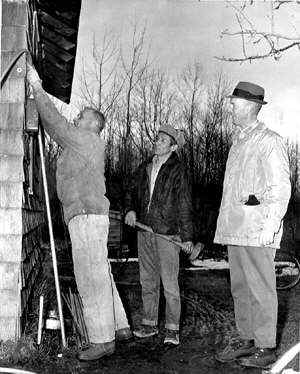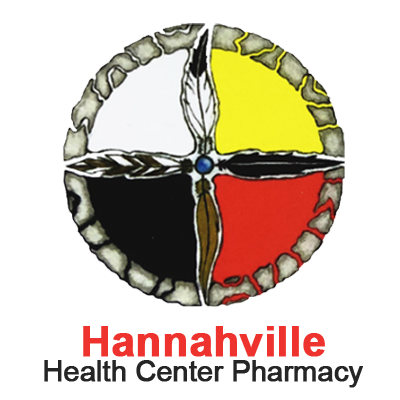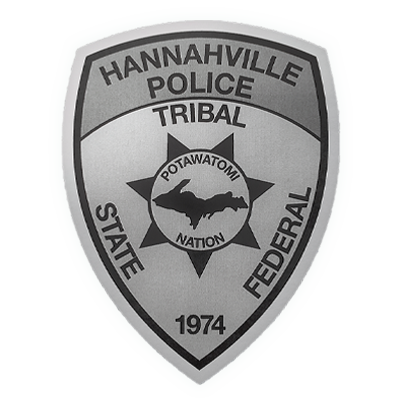Hannahville History
The Hannahville Indian Reservation is a Potawatomi Reservation and according to records the current location was founded in 1884 under the direction of Methodist Missionary, Peter Marksman. Little information is available through the Missionary records as the presiding elders or missionary failed to keep detailed records of the Mission.
The original settlement is thought to have been along the mouth of the Big Cedar River, on Lake Michigan.
The people of Hannahville are descendents of those who refused to leave Michigan in 1834 during the great Indian Removal. They lived with the Menominee in Northern Wisconsin, and the Ojibway and Ottawa people in Canada. In 1853 some these people began returning to Michigan. It was at this time they settled along the Big Cedar River.
Church records report that Marksman was sent to the area as an assistant, rather than the presiding Missionary. During this time he has been credited with finding a parcel of land and moving the Potawatomi people to the current location. According to church records, the people were very fond of Marksman wife, Hannah and named their community after her.
In 1913, Congress acknowledged the Hannahville Potawatomi and purchased 3.400 acres of land in scattered parcels and added another 39 acres in 1942. The people of Hannahville have been federally recognized since 1936.
The Potawatomi Indians are one of the three tribes making up the Three Fires Confederacy or as it is commonly referred to today as the Three Fires Society. The Three Fires Society consists of the Ojibway, the Ottawa and the Potawatomi tribes. The Ojibway are given the honor or keeping the “Original Teachings” alive and passing these teachings down through upcoming generations. The Ottawas are responsible for the “Provisions and Security” of all the tribes attending gatherings. Making sure that everyone has enough to eat and ensuring the attendees that their meeting place is secure from invasion and disruption is their major responsibility. The Potawatomi Indians are responsible for keeping the “Sacred Fire” alive, as it is the symbol of light and must be kept alive.
About Peter Marksman
by Cornelia M. Jensen
August 4, 1964
Peter Marksman, whose name now appears on the records, became a noteworthy Indian Christian leader. His father was an Indian medicine man who gave his son lessons in the conjurer’s art. Ma-diva-given-a-yaush, Shooting at the Mark, was the pagan name of this Indian boy. This, with his Christian name peter, gives us Peter Marksman. He was converted in the log school house of the Soo Indian Mission at Little Rapids, two miles below the falls of St. Mary’s River under the preaching of Rev. John Clark about 1833.
Peter Marksman early became an effective minister and at one time he preached on the Prodigal Son and the Indians were moved to tears. “They all, men, women and children, rose up saying we will arise up and embrace Christianity. Monday morning they all brought their images and bad medicines to me. I took them all and did burn them and destroy them before their eyes.”
He often knew severe exposure and hardship. In person he was scrupulously neat, tasty in dress, dignified and graceful in manner. In his prime he was eloquent as a preacher. This shining light of early Methodism among the Indians of the Upper Peninsula died at L’Anse on March 28, 1892, aged about 75.
For a short time the Methodists had a Cedar River mission. This we assume was the present Cedar River on the shores of Green Bay, midway between Escanaba and Menominee. In the 1870’s when logging operations opened her, this was a predominant Indian settlement. Fishing was good here both in the river and on the Bay.
In 1878 the conference assistance for Indian Missions on the Lake Superior District included $1175 to Cedar River Mission. Grand Island and Cedar River in 1979 reported 69 members and 22 probationers. In 1879 the conference supported an Indian Mission at Hannahville in Northern Menominee County. The redoubtable Peter Marksman opened this work and maintained it for several years. He suffered a deep personal sorrow when his eleven-year-old son died.
In 1835 the US Government had been in the process of moving the Potawatomi Indians to the west. A band of them broke away, worked northward, and between 1865-70 had settled at Harris. Their venerable chief Sah-panaiss, who had led them in their wanderings died in 1882 at the age of 100 years. On August 13, 1883, the Potawatomis gave Peter Marksman the power of attorney, enabling him to represent them in their struggles with the government and the surrounding whites.
The mission and the settlement were named Hannahville in honor of Hannah Marksman. In the early years about one thousand Indians lived here. In 1880 the Hannahville Indian Mission reported 39 members, 11 probationers, 6 baptisms and 50 in the Sunday school. In 1885 it had 35 members and Peter Marksman had received $25 on his $50 salary claim. There continued to be a small Indian Church here under Methodist auspices until 1940 when it was allowed to pass into other hands.
Electricity For Christmas

In December 1966 linemen from the Alger-Delta Cooperative Electric Association of Gladstone, MI began the task of running electrical lines from the Harris area (ie. West U.S. 2) onto the Hannahville Indian Reservation, a distance of approximately five miles. The cable installation was completed on Dec. 23, 1966.
After this task was completed a team of 40 volunteer electricians from throughout the state began wiring 16 homes to receive electricity. All 40 electricians were members of the International Brotherhood of Electricians. The 16 homes were completed and ready for “flipping the switch” late that evening.
In 1966 the union scale for electricians was $10 per hour for Saturday work. This would have been $400 per hour for the crew of 40 totaling $4,000 for the day’s work.
On Dec. 23, 1966 at 3 p.m. EST a small handful of local county officials and community members watched as “hotlines” were activated at Hannahville for the first time.
he “Lights for Christmas Project,” was a multi-agency sponsored effort. Agencies involved included the Upper Peninsula Committee for Area Progress (UPCAP), the Community Action Agency, the Bureau of Indian Affairs, and the Marquette Catholic Diocese.
The $6,000 abandonment deposit required earlier in the year by the Alger-Delta Cooperative Electric Association was donated by the Marquette Catholic Diocese. In addition, each of the 16 households to receive electricity were required to pay the Cooperative membership fee of $5. The request for the abandonment deposit was based on the pending Bureau of Indian Affairs housing project in Hannahville. If these new homes were not constructed in the area of the existing homes there was the possibility that the electric lines would be abandoned.
In the photo: Hannahville resident Henry Philemon Sr. (center), along with a BIA representative looks on as an electrician makes the final connections into the breaker box.
Milestones
| 1830’s | The Potawatomi “relocation” to Kansas. Some escaped, forced to march and made their way up the western side of Lake Michigan, settling in areas along the way up into Canada. Those who settled in the Cedar River area are the original descendants of Hannahville’s families today. | |
| 1833 | Residing Potawatomis, led by the Methodist Missionaries Peter and Hannah Marksman, organize the Hannahville Indian Mission. | |
| 1913 | The Hannahville Indian Community becomes a federally recognized tribe. | |
| 1942 | The Hannahville Indian Community consists of an estimated 134 members on 3,400 acres of land. | |
| 1942-1965 | Marks years of adversity for the Hannahville Indian Community. Community members have little money and are without electricity, running water and basic transportation. | |
| 1966 | Electricity is installed within the Hannahville Indian Community. | |
| 1978 | Two track roads paved in Hannahville Indian Community. | |
| 1981 | The “original” Hannahville Bingo Hall opens after years of community using Bingo to raise money for their baseball team. Prior to this, Bingo was held at the baseball field and players played from their cars. | |
| 1985 | The Hannahville Casino opens across from the Tribal Administration Center. 1987 The Hannahville Casino is renamed Chip-in Casino. | |
| 1991 | The first expansion of the Chip-In Casino opens at the present site. | |
| 1993 | February: | The new Nah Tah Wahsh School opens. |
| August: | Tribal/State Gaming Compact is signed by all Michigan Tribes and Governor John Engler at Nah Tah Wahsh School. | |
| 1994 | The remodeled Tribal Administration Center opens. | |
| 1995 | The new Hannahville Bingo Hall open. | |
| 1997 | February: | Hannahville’s Medical Center opens. Current registered tribal members number 611 residing on 5,000 acres. About half of these members live on tribal lands. |
| 1998 | December: | The new casino opens to the public with the first headline act appears in the Island Showroom. |
| 1999 | January: | The Convention Center opens. |
| July: | The New Bingo Hall opens. | |
| 2000 | May: | Island Resort & Casino RV Park opens. |
| October: | Island Oasis Convenience Store opens. | |
| 2005 | June: | The wastewater treatment plant is completed. $45 million dollar casino expansion project begins. |
| 2006 | January: | The 50,000 group tour arrives since December 1998. |
| December: | The newly expanded showroom, gaming floor and Beachcomber Restaurant & Bar Opens. | |
| 2007 | April: | New 11 story Palm Tower opens. |
| June: | Club Four One opens | |
| 2008 | July: | Sweetgrass, 18-hole championship golf course opens. |
| 2011 | May: | $2 million Convention Center expansion and renovation project is completed. |
| June: | Sweetgrass Golf Club hosts its first annual professional championship. The Island Resort Championship marks the first time in six years that an Upper Peninsula course has hosted a professional championship. | |
| October: | The Island Resort & Casino contracts with leading casino systems supplier Aristocrat to bring its recently released online play-for-fun solution to tribal gaming for the first time. | |






